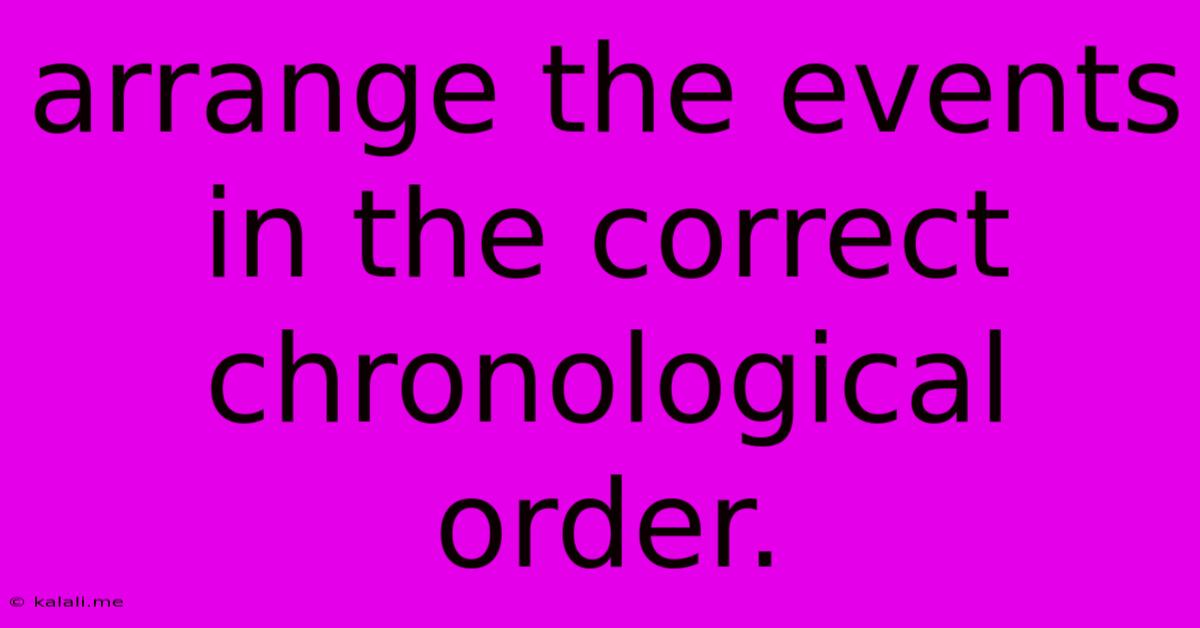Arrange The Events In The Correct Chronological Order.
Kalali
Jun 12, 2025 · 3 min read

Table of Contents
Arranging Events in Chronological Order: A Guide to Mastering Timelines
Organizing events chronologically is a fundamental skill, crucial for everything from writing compelling narratives to understanding historical contexts. Whether you're crafting a captivating blog post, writing a historical account, or simply recounting a personal experience, accurately arranging events in chronological order is key to clarity and understanding. This guide provides practical strategies to master this essential skill.
Meta Description: Learn how to arrange events chronologically, a crucial skill for clear storytelling and historical accuracy. This guide covers practical strategies and tips for mastering timelines, perfect for writers and researchers alike.
Understanding Chronological Order
Chronological order simply means arranging events according to when they happened, from earliest to latest. This linear progression of time provides a clear structure for understanding cause and effect, tracing development, and building a compelling narrative. Think of it as creating a timeline – a visual representation of events in their proper sequence.
Key Steps to Arranging Events Chronologically
Mastering chronological order involves several key steps:
-
Gather Information: Begin by collecting all the relevant information related to the events you intend to organize. This might involve reviewing documents, conducting research, or recalling personal memories. Ensure you have all the necessary details before you begin arranging.
-
Identify Key Events: Once you have your information, identify the key events that you want to include in your chronological sequence. Focus on the most significant events that contribute to the overall narrative. Avoid including irrelevant or minor details that might distract from the main storyline.
-
Determine Dates and Times (if possible): This step is crucial for accuracy. Pinpoint the dates and, if possible, times associated with each event. If exact dates are unavailable, use approximations (e.g., "early spring," "around 1985") but strive for as much precision as possible.
-
Create a Timeline (Optional but Highly Recommended): Visually representing the events on a timeline can significantly simplify the process. You can use a simple chart, a spreadsheet, or even a piece of paper to arrange the events sequentially. This visual aid helps to identify gaps, overlaps, or inconsistencies in your timeline.
-
Arrange Events Sequentially: Now, arrange your events in order from the earliest to the latest. Carefully review your timeline to ensure the sequence is accurate and logical. Consider using a table or list format to present the chronologically ordered events.
-
Refine and Review: Once you have arranged the events, carefully review your work to ensure accuracy and clarity. Look for any inconsistencies or gaps in the narrative. Refining your timeline ensures the final presentation is both accurate and engaging.
Tips for Effective Chronological Ordering
- Use clear and concise language: When describing the events, use precise language that avoids ambiguity.
- Maintain consistent tense: Stick to either past tense or present tense throughout your writing to maintain consistency and clarity.
- Provide context: Give sufficient background information to help readers understand the significance of each event.
- Add transitions: Use transitional words and phrases (e.g., "then," "afterward," "subsequently") to connect events smoothly and logically.
- Consider using visual aids: Charts, graphs, and images can enhance the presentation of chronologically ordered information, making it more engaging and easier to understand.
Conclusion
Mastering the art of arranging events chronologically is a valuable skill that enhances communication, improves comprehension, and enables the creation of clear, compelling narratives. By following the steps outlined above, you can effectively organize information, avoid chronological errors, and create presentations or narratives that are both accurate and engaging. Practice is key – the more you work with timelines and chronological ordering, the more naturally it will become.
Latest Posts
Latest Posts
-
What Is The Lcm Of 8 12 And 15
Jun 13, 2025
-
Which Of The Following Is Not Part Of A Nucleotide
Jun 13, 2025
-
Which Term Means Movement Toward The Midline
Jun 13, 2025
-
Which Of The Following Is Not Included In National Income
Jun 13, 2025
-
Where Is Most Of The Mass Of The Atom Found
Jun 13, 2025
Related Post
Thank you for visiting our website which covers about Arrange The Events In The Correct Chronological Order. . We hope the information provided has been useful to you. Feel free to contact us if you have any questions or need further assistance. See you next time and don't miss to bookmark.